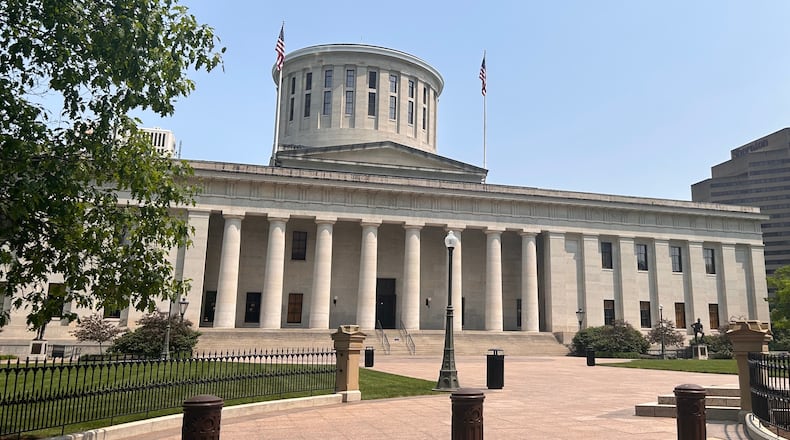Springfield front-and-center
Credit: NYT
Credit: NYT
Internet rumors evolved into attention-grabbing presidential debate fodder this September and subsequently thrust Springfield into the national limelight.
For weeks and months, the city — which had accumulated an estimated 15,000 Haitian immigrants over recent years in part due to a laissez-faire temporary immigration status and an array of unfilled manufacturing jobs — was used as a dramatic, and often false, example of how border policy can impact non-border states.
Through various mediums, Springfield’s Haitians were accused of capturing and consuming their neighbors’ pets as well as geese from local parks to claims from now President-elect Donald Trump that the Haitians were “destroying [Springfield’s] way of life,” including insinuations that Haitians were raping, sodomizing and murdering girls. Local officials and law enforcement refute each of these accusations.
Still, Trump promised to commence “the largest deportation in the history of our country” starting in Springfield once he’s sworn in. His administration has also threatened to end Haitians’ Temporary Protected Status, a longstanding U.S. policy that grants vetted Haitians the right to stay in America while their home country is under severe distress due to gangs and political violence.
Legally, these things might be easier said than done and only time will tell if this is more rhetoric than action.
Springfield’s Haitian influx and the ensuing national reaction have caused real problems for the city that will continue to play out in 2025.
The state has taken action to reduce the number of accidents in Clark County caused by Haitian drivers; healthcare providers are adjusting to the increasing demands of a largely unvaccinated population; schools are adjusting to a significant portion of new students who are more proficient in Haitian Creole than English; and local schools have an expanded police presence following a series of bomb threats to the community.
Red wave makes red state redder
Credit: AP
Credit: AP
Over the past 12 years, Ohio has gone from one of the nation’s preeminent political tossups to one of the surest red states in the country, and November’s election proved the rule.
Trump won the state for the third time in a row, this time by 11 points, the highest margin of victory posted by any presidential candidate in Ohio for 40 years.
Since 2006, Ohio has had split representation in the U.S. Senate, but that will change this January once Senator-elect Bernie Moreno, a Republican businessman from the Cleveland area, officially unseats Democratic Sen. Sherrod Brown.
Once Moreno takes the oath, Ohio will have only one Democrat elected in a statewide election: Ohio Supreme Court Associate Justice Jennifer Brunner, who saw her two Democratic colleagues lose their seats in November as Republicans took a six-to-one advantage on the state’s top bench.
With these results and more, Ohio became a glowing example of the “red wave” that seemed to wash over America as a whole in 2024.
“We saw a uniform shift across the country. And the same was true in Ohio,” said Lee Hannah, professor of political science at Wright State University.
Transgender policies
In 2024, Ohio adopted three new policies through its Republican-dominated legislature that specifically target transgender youth and will considerably change the landscape for those kids and their families in 2025.
The most publicized of those policies was a ban on new gender-affirming medical care for Ohio minors, which went into law in 2024 following the legislature’s successful override of Gov. Mike DeWine’s veto and the state’s successful defense of the bill in a Franklin County court.
Under it, Ohio minors not already receiving gender-affirming hormone treatments were blocked from starting puberty blockers or cross-sex hormones. Previously, transgender minors and their parents were able to receive such care with their doctors’ approval.
In the same bill, Ohio also blocked transgender girls from participating in girls’ scholastic sports in grade school and in college, trumping the permissive transgender athlete policies of the Ohio High School Athletic Association and the NCAA in Ohio that have largely limited the number of transgender girls playing girls’ sports.
In Senate Bill 104, the legislature officially barred transgender students from preschool to college from using the school bathrooms that correspond to their gender.
The bill, set to become effective in early 2025, will require public and chartered nonpublic schools and all institutions of higher education to designate facilities for the “exclusive use of students of either the male biological sex or the female biological sex,” and enforce the rule.
Universal private school vouchers
Ohio’s 2023 adoption of a universal, sliding-scale private school voucher system led to more than a three-fold increase in voucher usage in the 2023-2024 school year, but enrollment at schools that accept vouchers grew by only 3.7%.
The data, uncovered in an analysis from this news outlet, suggests that the taxpayer program meant to increase lower-income families’ ability to afford private school is largely only subsidizing families who already send their kids to private schools.
The findings add another layer to a long-held Statehouse debate on the utility of school vouchers.
Senate President Matt Huffman, an incoming representative preliminarily elected Speaker of the House, told this outlet that he believes vouchers will, in the end, grant more flexibility to Ohio students regarding where they go to school.
Huffman, a Lima Republican, framed it as a cost-saving bet, given that the average school voucher given out by the state last year (around $6,000) is cheaper than the average cost of a student going to public schools, which he put at about $14,500.
“The taxpayer gets a good deal with each student that takes one of these scholarships and goes to a less expensive alternative school,” Huffman said.
House Minority Leader Allison Russo, D-Upper Arlington, believes universal school vouchers moreso indicate a de-prioritization of public education.
“At some point in the future, in the very near future, because we have limited resources in our state budget and we have to have a balanced budget, we are now competing,” Russo said. “The public school funding will be usurped by the voucher funding, and that is very alarming to me. And yes, I think that has been the intent all along.”
Record capital budget; local projects windfall
Credit: Vic Kincer
Credit: Vic Kincer
In June, the Ohio General Assembly approved a $4.2 billion budget on capital projects, which included the appropriations for a $717 million pot of surplus tax revenue created in part due to an influx of federal COVID-19 dollars that offset much of the state’s spending.
The resulting bill sent more than $166.4 million for capital project construction in this eight-county region of southwest Ohio, including a $10 million investment to complete the first phase of a new state-run behavioral health hospital in Dayton; a $27.5 million state investment toward keeping the Western & Southern Open tennis tournament in Mason; and a $23.1 million investment in a new Miami University hall, among other things.
Montgomery County Sen. Niraj Antani, R-Miami Twp., was the lone vote against the capital budget in the Senate. On the Senate floor, Antani said that he’d rather the $717 million go toward a tax refund of some sort.
“Hardworking Ohioans — business owners, union members, teachers, people in the health care front lines — they could be seeing $700 million of their money being returned to them. But, because we’re choosing to give this to special projects, they are not,” Antani said.
Antani’s tax refund idea was criticized by Senate Minority Leader Nickie Antonio, D-Lakewood, who argued that spreading $717 million among Ohio’s population of nearly 12 million people would result in what she characterized as a paltry sum of tax relief per person.
“Rather than give each person in the state of Ohio $63, we’re actually making investments that are going to transform all of our communities,” Antonio said. She called the capital budget, and particularly the special projects fund, one of best acts of bipartisanship she had seen in recent years.
For more stories like this, sign up for our Ohio Politics newsletter. It’s free, curated, and delivered straight to your inbox every Thursday evening.
Avery Kreemer can be reached at 614-981-1422, on X, via email, or you can drop him a comment/tip with the survey below.
About the Author





